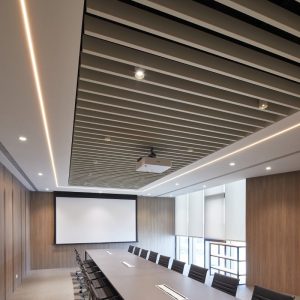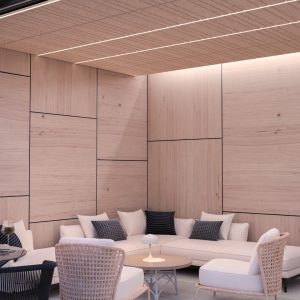When it comes to designing ceilings that deliver as much acoustically as they do aesthetically, few material choices deliver as readily as aluminum ceiling clouds. They represent a beautiful fusion of form and function that turns ordinary ceilings into architectural pieces, while significantly improving the acoustics of tricky high-volume spaces.
Aluminum ceiling clouds have become a defining feature in modern ceiling systems, offering a solution that blends visual drama with acoustic performance. Unlike traditional drop ceilings, these decorative floating ceilings create depth and dimension while reducing unwanted noise in large or high-traffic spaces. Whether used in open offices, lobbies, or hospitality environments, they serve as both suspended architectural elements and functional acoustic ceiling treatments.
By combining style, performance, and adaptability, aluminum ceiling clouds give architects and designers a versatile tool for shaping the character of a space. But what exactly are they, and how do they elevate commercial ceiling design?
What are Aluminum Ceiling Clouds?
At their core, aluminum ceiling clouds are suspended ceiling clouds–floating architectural features designed to shape a room’s look and sound. Unlike traditional ceiling tiles that create a flat, uniform plane, ceiling clouds are hung in intentional patterns, giving the overhead plane dimension and rhythm. They are especially valued in custom ceiling architecture, where form and function must align.
Made from lightweight yet durable materials, they are engineered to meet the demands of today’s interiors. Architects use them to create decorative floating ceilings that soften the scale of large spaces, while contractors appreciate their relative ease of installation and long-term performance. Their modularity means they can be integrated into both small and expansive projects, from boutique retail to sprawling office campuses.
Beyond aesthetics, aluminum ceiling clouds offer solutions to the challenges of high ceiling noise control. In environments filled with hard flooring, glass, and metal, sound often bounces uncontrolled, making it difficult to communicate or concentrate. Cloud ceiling systems provide both a visual anchor and a layer of sound absorption, making them a staple in open office ceiling design as well as educational, healthcare, and hospitality settings.
Design and Functionality
Design flexibility is one of the most compelling aspects of aluminum ceiling clouds. They are typically installed as panels or grouped into striking geometric formations that redefine the character of a space. Their lightweight construction makes them easier to suspend than heavier materials, yet the inherent strength of aluminum ensures that they are built to last.
Available in a wide range of surface options–including brushed aluminum, anodized metallics, wood grain textures, and custom powder coatings–these ceiling clouds can align with virtually any interior palette. The ability to match or contrast finishes makes them an effective choice for customizable metal ceilings, where branding or design intent drives material selection.
Their versatility extends beyond surface finishes. Designers can choose between solid styles for a sleek, monolithic effect or open-grid patterns that allow lighting and mechanical systems to remain visible. Clouds are also available in flat, convex, or concave profiles, and when specified as modular ceiling clouds, they can be scaled, combined, or staggered to create layered architectural effects.
This combination of practicality and aesthetics sets aluminum ceiling clouds apart from traditional ceiling systems. Instead of concealing utilities, they transform the ceiling into a statement feature–proof that metal ceiling aesthetics can be as expressive as they are functional.
Acoustical Benefits of Ceiling Clouds
While their striking look captures initial attention, the acoustical performance of aluminum ceiling clouds is equally important. Large, open spaces often suffer from echoes and reverberation, especially when filled with reflective surfaces like polished concrete, glass, or stone. In these environments, conversations can become muddled and background noise overwhelming.
To address these acoustical challenges, Material LogIQ crafts aluminum ceiling clouds from InvisiPerf Metal, which delivers up to 0.80 NRC (Noise Reduction Coefficient), without the need for an acoustical backer. This delivers superior sound absorption from a visually solid panel, placing them in the same performance class as many high-quality aluminum acoustic panels, but with the added benefit of design flexibility.
In offices, libraries, and classrooms, strategically placed ceiling clouds can mitigate distractions by softening sound transmission across the space. In lobbies, restaurants, or performance venues, these perforated aluminum panels provide the high ceiling noise control necessary for comfort without sacrificing style. By integrating lightweight acoustic panels into their design, aluminum ceiling clouds help architects create environments that are both visually dynamic and acoustically well-tuned.
Ultimately, aluminum ceiling clouds are not just design accents–they are complete cloud ceiling systems that deliver on visual impact, flexibility, and sound performance.
Installation and Design Flexibility
One of the key advantages of aluminum ceiling clouds is how easily they integrate into modern ceiling systems. While they bring high design value, they are engineered with practicality in mind, making them attractive to both architects and contractors. Their lightweight construction means fewer structural concerns compared to heavier materials, and they can be installed as stand-alone features or as part of larger cloud ceiling systems. This flexibility supports everything from dramatic custom ceiling architecture in public spaces to more understated treatments in offices or classrooms.
Customizing Ceiling Cloud Designs
Customization is central to the appeal of aluminum ceiling clouds. The fabrication process allows for a variety of forms–square, circle, wave, or custom shapes–letting designers tailor the ceiling to match the character of the space. Many existing systems can be specified with perforated aluminum panels, enhancing both acoustic performance and lighting diffusion. Surface finishes are equally adaptable–anodized metallics, brushed textures, and powder-coated colors make it possible to align with brand palettes or broader design schemes.
These choices allow aluminum ceiling clouds to function as more than just suspended architectural elements–they become part of a space’s identity. By combining flexible geometry with finish options, they serve as customizable metal ceilings that meet both technical requirements and aesthetic ambitions.
Installation Best Practices
Although aluminum clouds are relatively straightforward to install, proper planning ensures the best results. Modular ceiling cloud systems allow for repeatable, clean installations, making them efficient to specify on multi-location projects. Architects and contractors should consider weight load, ceiling height, and lighting integration early in the design process to maximize impact and performance.
Equally important, these systems are designed for adaptability. If a layout needs to evolve–whether for a tenant improvement or a new workplace strategy–aluminum ceiling clouds can be uninstalled or relocated with minimal disruption. This adaptability underscores their value in commercial ceiling design, where long-term flexibility is just as important as first impressions.
Where Design Meets Performance
Aluminum ceiling clouds demonstrate how design and engineering can work together to elevate the built environment. More than simply visual accents, they are complete aluminum ceiling systems–lightweight, modular, and adaptable to a wide range of architectural goals. Their presence transforms ceilings from passive surfaces into active design features, proving that metal ceiling aesthetics can deliver both visual impact and measurable performance.
A defining feature of Material LogIQ’s approach is acoustic efficiency. Unlike many products that require additional absorptive backers, our aluminum ceiling clouds are engineered to achieve up to a 0.80 NRC rating on their own. This eliminates the need for secondary materials while still providing the performance of highly effective ceiling sound absorbers. For projects focused on high ceiling noise control, this built-in capability simplifies specification and installation without compromising results.
In more complex spaces, aluminum clouds can be paired with other architectural ceiling panels or even metal ceiling baffles to balance absorption and diffusion. This versatility makes them an excellent choice for open office ceiling design, auditoriums, and lobbies where acoustics and aesthetics must align seamlessly. Whether used alone as bold suspended architectural elements or integrated into larger custom ceiling architecture, they perform with consistency and style.
Designers and specifiers can apply these benefits to make their next project stand out. Material LogIQ InvisiPerf Metal aluminum ceiling clouds offer a future-ready solution–customizable, acoustically capable, and visually impactful. To explore material samples or request design support, connect with our team and discover how these systems can transform your next commercial or public interior.





